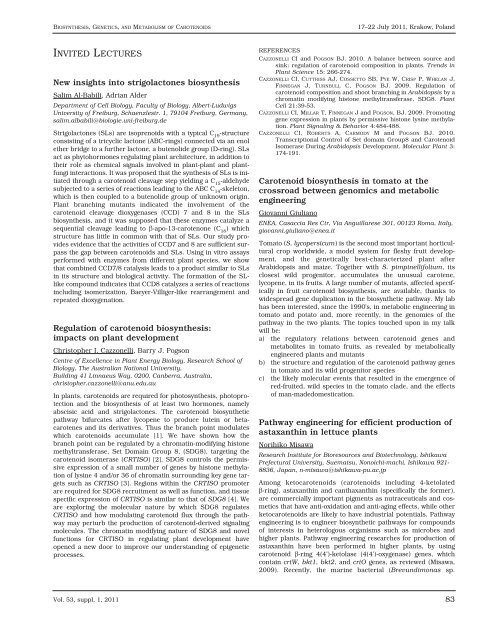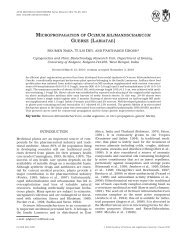ACTA BIOLOGICA CRACOVIENSIA
ACTA BIOLOGICA CRACOVIENSIA
ACTA BIOLOGICA CRACOVIENSIA
Create successful ePaper yourself
Turn your PDF publications into a flip-book with our unique Google optimized e-Paper software.
BIOSYNTHESIS, GENETICS, AND METABOLISM OF CAROTENOIDS<br />
INVITED LECTURES<br />
New insights into strigolactones biosynthesis<br />
Salim Al-Babili, Adrian Alder<br />
Department of Cell Biology, Faculty of Biology, Albert-Ludwigs<br />
University of Freiburg, Schaenzlestr. 1, 79104 Freiburg, Germany,<br />
salim.albabili@biologie.uni-freiburg.de<br />
Strigolactones (SLs) are isoprenoids with a typical C 19 -structure<br />
consisting of a tricyclic lactone (ABC-rings) connected via an enol<br />
ether bridge to a further lactone, a butenolide group (D-ring). SLs<br />
act as phytohormones regulating plant architecture, in addition to<br />
their role as chemical signals involved in plant-plant and plantfungi<br />
interactions. It was proposed that the synthesis of SLs is initiated<br />
through a carotenoid cleavage step yielding a C 15 -aldehyde<br />
subjected to a series of reactions leading to the ABC C 14 -skeleton,<br />
which is then coupled to a butenolide group of unknown origin.<br />
Plant branching mutants indicated the involvement of the<br />
carotenoid cleavage dioxygenases (CCD) 7 and 8 in the SLs<br />
biosynthesis, and it was supposed that these enzymes catalyze a<br />
sequential cleavage leading to β-apo-13-carotenone (C 18 ) which<br />
structure has little in common with that of SLs. Our study provides<br />
evidence that the activities of CCD7 and 8 are sufficient surpass<br />
the gap between carotenoids and SLs. Using in vitro assays<br />
performed with enzymes from different plant species, we show<br />
that combined CCD7/8 catalysis leads to a product similar to SLs<br />
in its structure and biological activity. The formation of the SLlike<br />
compound indicates that CCD8 catalyzes a series of reactions<br />
including isomerization, Baeyer-Villiger-like rearrangement and<br />
repeated dioxygenation.<br />
Regulation of carotenoid biosynthesis:<br />
impacts on plant development<br />
Christopher I. Cazzonelli, Barry J. Pogson<br />
Centre of Excellence in Plant Energy Biology, Research School of<br />
Biology, The Australian National University,<br />
Building 41 Linnaeus Way, 0200, Canberra, Australia,<br />
christopher.cazzonelli@anu.edu.au<br />
In plants, carotenoids are required for photosynthesis, photoprotection<br />
and the biosynthesis of at least two hormones, namely<br />
abscisic acid and strigolactones. The carotenoid biosynthetic<br />
pathway bifurcates after lycopene to produce lutein or betacarotenes<br />
and its derivatives. Thus the branch point modulates<br />
which carotenoids accumulate [1]. We have shown how the<br />
branch point can be regulated by a chromatin-modifying histone<br />
methyltransferase, Set Domain Group 8, (SDG8), targeting the<br />
carotenoid isomerase (CRTISO) [2]. SDG8 controls the permissive<br />
expression of a small number of genes by histone methylation<br />
of lysine 4 and/or 36 of chromatin surrounding key gene targets<br />
such as CRTISO [3]. Regions within the CRTISO promoter<br />
are required for SDG8 recruitment as well as function, and tissue<br />
specific expression of CRTISO is similar to that of SDG8 [4]. We<br />
are exploring the molecular nature by which SDG8 regulates<br />
CRTISO and how modulating carotenoid flux through the pathway<br />
may perturb the production of carotenoid-derived signaling<br />
molecules. The chromatin modifying nature of SDG8 and novel<br />
functions for CRTISO in regulating plant development have<br />
opened a new door to improve our understanding of epigenetic<br />
processes.<br />
Vol. 53, suppl. 1, 2011<br />
17–22 July 2011, Krakow, Poland<br />
REFERENCES<br />
CAZZONELLI CI and POGSON BJ. 2010. A balance between source and<br />
sink: regulation of carotenoid composition in plants. Trends in<br />
Plant Science 15: 266-274.<br />
CAZZONELLI CI, CUTTRISS AJ, COSSETTO SB, PYE W, CRISP P, WHELAN J,<br />
FINNEGAN J, TURNBULL C, POGSON BJ. 2009. Regulation of<br />
carotenoid composition and shoot branching in Arabidopsis by a<br />
chromatin modifying histone methyltransferase, SDG8. Plant<br />
Cell 21:39-53.<br />
CAZZONELLI CI, MILLAR T, FINNEGAN J and POGSON, BJ. 2009. Promoting<br />
gene expression in plants by permissive histone lysine methylation.<br />
Plant Signaling & Behavior 4:484-488.<br />
CAZZONELLI CI, ROBERTS A, CARMODY M and POGSON BJ. 2010.<br />
Transcriptional Control of Set domain Group8 and Carotenoid<br />
Isomerase During Arabidopsis Development. Molecular Plant 3:<br />
174-191.<br />
Carotenoid biosynthesis in tomato at the<br />
crossroad between genomics and metabolic<br />
engineering<br />
Giovanni Giuliano<br />
ENEA, Casaccia Res Ctr, Via Anguillarese 301, 00123 Roma, Italy,<br />
giovanni.giuliano@enea.it<br />
Tomato (S. lycopersicum) is the second most important horticultural<br />
crop worldwide, a model system for fleshy fruit development,<br />
and the genetically best-characterized plant after<br />
Arabidopsis and maize. Together with S. pimpinellifolium, its<br />
closest wild progenitor, accumulates the unusual carotene,<br />
lycopene, in its fruits. A large number of mutants, affected specifically<br />
in fruit carotenoid biosynthesis, are available, thanks to<br />
widespread gene duplication in the biosynthetic pathway. My lab<br />
has been interested, since the 1990's, in metabolic engineering in<br />
tomato and potato and, more recently, in the genomics of the<br />
pathway in the two plants. The topics touched upon in my talk<br />
will be:<br />
a) the regulatory relations between carotenoid genes and<br />
metabolites in tomato fruits, as revealed by metabolically<br />
engineered plants and mutants<br />
b) the structure and regulation of the carotenoid pathway genes<br />
in tomato and its wild progenitor species<br />
c) the likely molecular events that resulted in the emergence of<br />
red-fruited, wild species in the tomato clade, and the effects<br />
of man-madedomestication.<br />
Pathway engineering for efficient production of<br />
astaxanthin in lettuce plants<br />
Norihiko Misawa<br />
Research Institute for Bioresources and Biotechnology, Ishikawa<br />
Prefectural University, Suematsu, Nonoichi-machi, Ishikawa 921-<br />
8836, Japan, n-misawa@ishikawa-pu.ac.jp<br />
Among ketocarotenoids (carotenoids including 4-ketolated<br />
β-ring), astaxanthin and canthaxanthin (specifically the former),<br />
are commercially important pigments as nutraceuticals and cosmetics<br />
that have anti-oxidation and anti-aging effects, while other<br />
ketocarotenoids are likely to have industrial potentials. Pathway<br />
engineering is to engineer biosynthetic pathways for compounds<br />
of interests in heterologous organisms such as microbes and<br />
higher plants. Pathway engineering researches for production of<br />
astaxanthin have been performed in higher plants, by using<br />
carotenoid β-ring 4(4’)-ketolase (4(4’)-oxygenase) genes, which<br />
contain crtW, bkt1, bkt2, and crtO genes, as reviewed (Misawa,<br />
2009). Recently, the marine bacterial (Brevundimonas sp.<br />
83












